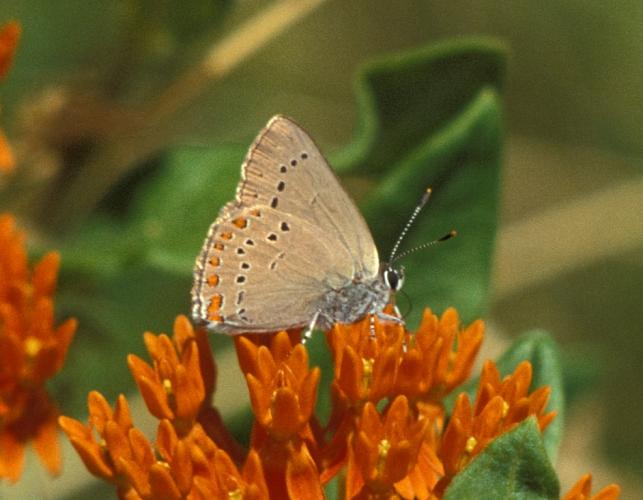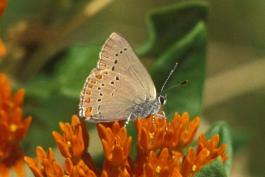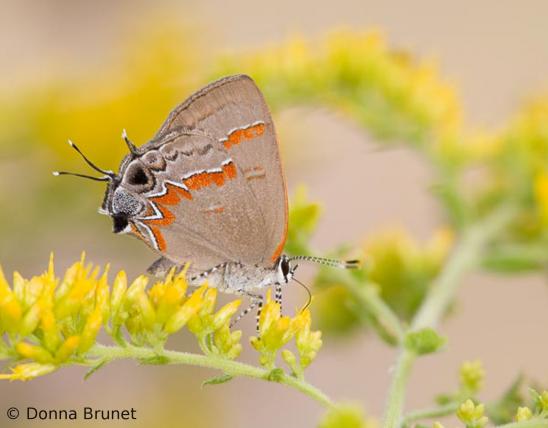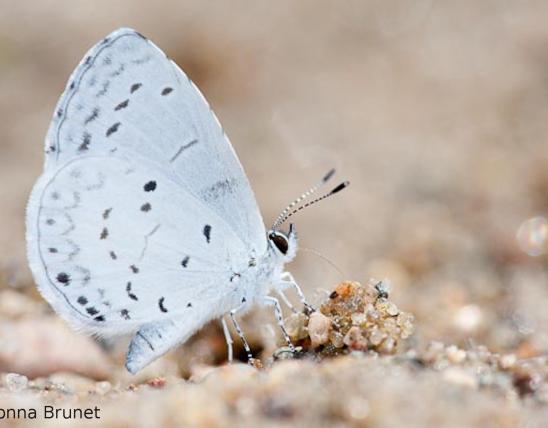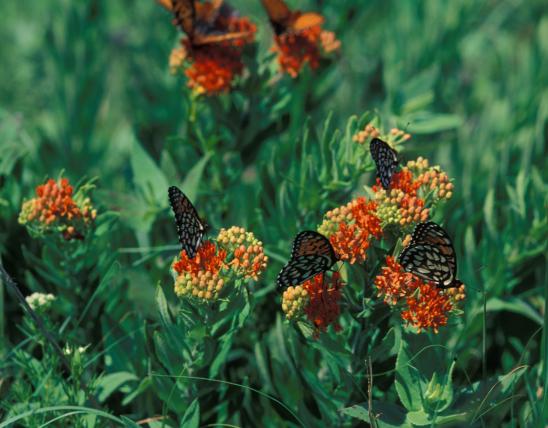
Coral hairstreaks are the only Missouri hairstreaks lacking hindwing “tails” and without a blue spot on the outer hindwing edge. They are light grayish brown below, with a distinctive row of orange spots along the outer edge of the hindwing. The undersides of all four wings have postmedian bands — running just outside the wing’s midline — of black spots rimmed with white.
Larvae are downy green to yellowish green, with rosy pinkish patches at the front and rear.
Similar species: Missouri has many species of hairstreaks, blues, azures, coppers, and elfins. The one most likely to be confused with the coral hairstreak is the Acadian hairstreak (S. acadica), which is usually only seen in northern Missouri. If an Acadian hairstreak has its tails broken off, it looks very similar. But it possesses the blue outer hindwing spot the coral lacks, and it is less brownish and more bluish gray.
Wingspan: 1–1½ inches.
Statewide.
Habitat and Conservation
Coral hairstreaks most frequently occur in overgrown fields and pastures, and edges of open and wooded habitats. They are always local and uncommon. The caterpillars feed at night in trees. By day, they hide in the leaf litter at the bases of host trees. This is one of the hairstreak species whose larvae are tended by ants, which protect them from insect predators and feed on the sugary liquid excreted by the caterpillars.
Food
Caterpillars feed at night on the flowers, developing fruits, and leaves of trees in the rose family, such as wild plum and cherry (Prunus spp.).
Adults take nectar from a variety of wildflowers in open, grassy areas. They are especially attracted to flowers in the dogbane/milkweed family, especially butterfly weed, Asclepias tuberosa. Eminent Missouri lepidopterists Richard and Joan Heitzman wrote that adult coral hairstreaks are “addicted to the flowers of butterfly weed” and that “other flowers are practically ignored when this plant is present.”
Status
Single-brooded resident species.
Life Cycle
There is only one brood, with adults flying in June through July. Males perch on shrubs and wait for females to approach. Females lay eggs singly on twigs of the food plants or at the bases of host plants. Eggs overwinter on twigs. Caterpillars feed on flowers and fruits. Ants tend the caterpillars, protecting them from insect predators and receiving a sugary liquid (called honeydew) that the larvae excrete from abdominal glands. The ants move the caterpillars to the ground to hide them during the day, and they may even move them to better feeding sites on nearby trees.
Human Connections
What a pretty butterfly. Do you need another reason to plant bright orange native butterfly weed in your flower garden?
Good news for orchard growers: Coral hairstreak larvae apparently prefer native plums, cherries, and other shrubs over cultivated fruit trees.
Ecosystem Connections
This species provides a great example of mutualism, which can be defined as an interaction between two different species where both species benefit. In this case, ants receive the sugary honeydew to eat, while the caterpillars are protected by the ants from predatory lacewing and ladybug larvae, and from parasitoid ichneumon wasps. The ants also transport the larvae to the ground for daytime safety, and apparently move the larvae to nearby trees with more or better foliage. It almost sounds like the arrangement between cows and dairy farmers, doesn’t it. In fact, a very similar kind of relationship — between ants and aphids — is sometimes called “farming,” “herding,” and “dairying.”
